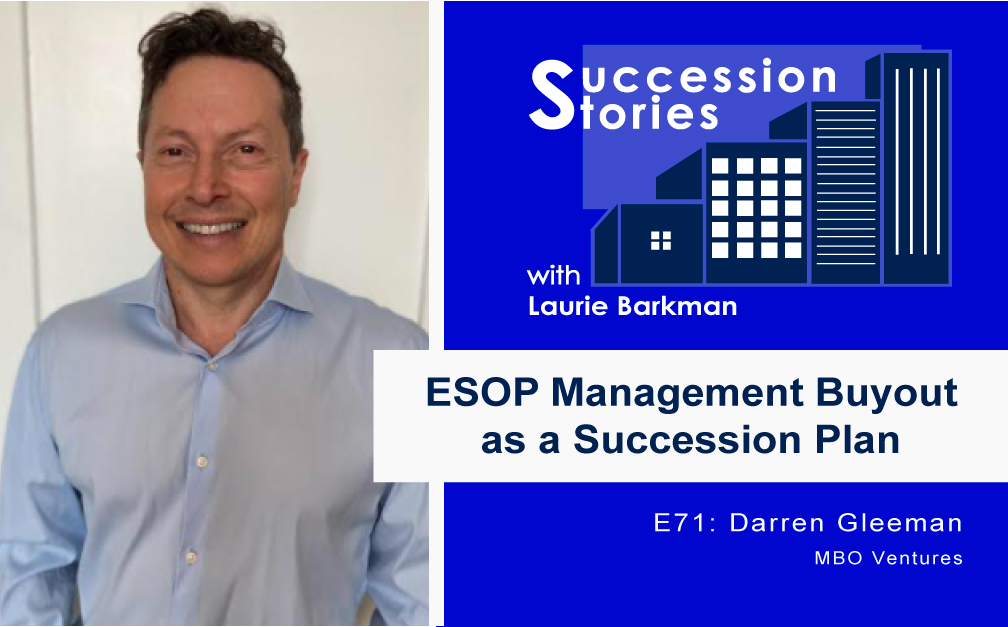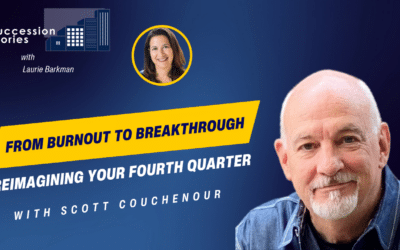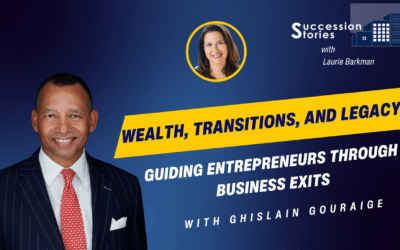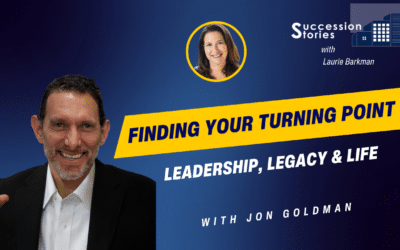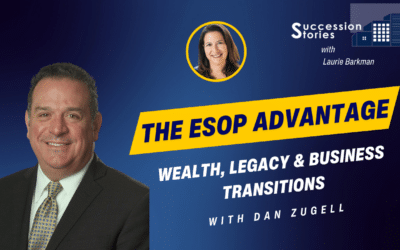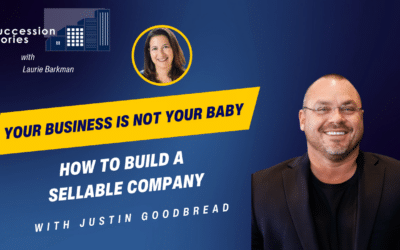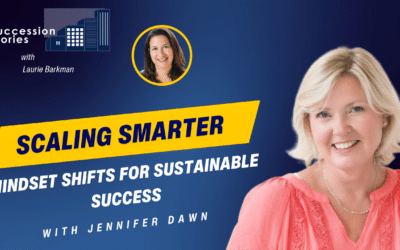Explore how ESOP management buyouts can be a great succession plan as a way to transfer your family-owned business to your children and employees. Laurie Barkman and Darren Gleeman, an ESOP expert and Partner at MBO Ventures, discuss why you might consider an ESOP over selling to a private equity firm. In addition to substantial tax incentives, your children can get warrants to buy back a large chunk of the company in the future. Listen in to learn more about the immense possibilities ESOPs can create for your business.
- How ESOPs can create a win-win scenario for business owners, stakeholders and employees
- How an ESOP can reduce tax obligations
- Why setting up an ESOP structure can make it easier to transfer your business
- The importance of incentives such as ESOPs as a way to incentivize your team and retain your workforce
- How Woman-Owned, Veteran-Owned, and Minority Business Enterprises can sell to an ESOP and maintain their certification
About:
The Succession Stories podcast is hosted by Laurie Barkman, Founder of SmallDotBig.
We’ll help you maximize business value, plan your exit transition, and get rewarded for all of your hard work by finding the right buyer or seller.
Transcript:
Laurie Barkman:
Darren Gleeman, welcome to Succession Stories. This is going to be a really interesting episode for people who are interested in learning more about vehicles to have a succession in their company through what’s called an ESOP. It sounds scary. It sounds like a 401k thing. It sounds like something we might have heard about, but we’re not really sure, and I think you are the perfect person to come in and talk about the business side. The big why, of why an ESOP management buyout is a great succession plan, so welcome.
Darren Gleeman:
Thank you, Laurie. Absolutely. An ESOP is just another way to sell your company, it’s another exit, and it’s an exit with phenomenal tax incentives and tax subsidies so I believe it’s the best way to go.
Laurie Barkman:
Let’s start with you. What’s your background? What’s your story?
Darren Gleeman:
My background is, I had a company back in, I started in 2000, I came up with a pattern in the stock market with two of my co-workers and this was back actually in ’99 or 2000, we were able to trade this stock and like a real honest to goodness pattern, not like the Fibonacci sequence drops to 70%. This is actually real, a real pattern. We were able to trade five, six stocks at a time, and I had the idea, what if we can go and trade all 7000 symbols on the stock exchange at once, and of course, it’s a great idea. Went to the boss, and he’s like, “Great idea, but way too risky to be in the marketplace like that.” Okay, so we left the firm, went to a much smaller company, and presented to them and they said, “Yeah, we’ll allow you to do it, but we won’t allow you, we won’t give you any money,” which turned out to be a blessing in disguise, because we had to then use our own money for it, which turned out to be a good idea.
We launched it back in, I think, finally right after 9/11, November of 2001. We launched our first program, meaning the computer just ran the entire operation, and after some, maybe like two or three weeks, debugged, it worked and worked extremely well. What we found from that is we had an enormous amount of additional data, which we never would have been able to get without computerizing. Then from that additional data, we were able to find a huge amount, a lot more patterns, and that began the beginning of the company. So we grew and by 2018, we were doing over one half percent of the entire US market every single day.
Laurie Barkman:
Wow.
Darren Gleeman:
Yeah, it’s a significant amount of billions and billions of shares of stock, and it’s a tremendous amount of stress. We opted to exit in 2018 and at that point, I was gonna go into private equity, but I didn’t really see a huge advantage in private equity for me. But I also had known about ESOPs and that’s when I got involved in that space and the reason why is that ESOPs, to me, were just such a huge advantage over any other structure, and you’re doing really good for the employees of the company, because they become employee owners, and the owners that want to sell to them, it turns out, they actually are going to make more money by selling to their employees than by selling to private equity. So it was a win-win scenario, and that’s how I got involved with [ESOPs].
Laurie Barkman:
Is that when you started MBO Ventures, around 2018?
Darren Gleeman:
I started MBO Ventures in 2019. 2018 was more of a relaxing time.
Laurie Barkman:
Well deserved.
Darren Gleeman:
Yeah, and still getting out of my company. I still was there, up until up until 2019 while I was still looking into different ventures, and I got involved in 2019 with MBO Ventures, and so MBO is my company. We are the independent merchant bank for a company called CSG Partners. CSG Partners is the nation’s largest ESOP investment bank and so I go out there and I try to find opportunities for CSG. Some of the opportunities would be great where I can go out and put my own money up to do an ESOP, or in a lot of cases, it’s just, companies want to do it themselves and we help structure them or CSG structures the ESOP for them.
Laurie Barkman:
Gotcha. So you’re clearly a numbers guy. You’ve been in this game, if I can call it that, a long time, and you’ve seen how companies can benefit because of an ESOP which is why I invited you onto the show. I think from the business side, it’s super interesting to learn about how companies are benefiting from those so if you would, let’s just talk about, who are some of the largest ESOPS that people might know of? They might be surprised to know who some companies are.
Darren Gleeman:
The largest ESOP, I think, is Publix, which is a supermarket down in the southern states and that is the largest one. It’s a phenomenal ESOP. They’ve been doing it for quite a while. Another pretty large ESOP in the northern states in the supermarket world is a company called Wawa. Anybody that’s been to school in Philadelphia, they know Wawa and that also is a, that’s a minority owned ESOP. That’s also a great company.
Laurie Barkman:
Lots of different companies are ESOPs in different industries and we’ll talk more about that, but we see it in construction, engineering, architecture, so it’s not an uncommon thing. It’s more common than we think, and it’s probably because of the benefits, right?
Darren Gleeman:
It’s extremely common. There’s about 7000 ESOPs, and the biggest problem with ESOPs is awareness. People just don’t know what they are, and as you said in the beginning, people think, “Oh, it’s some type of 401(k) thing. It’s not really for me.” Once we go in, and we explain what it is, you always get, “Wow, that seems too good to be true, and how is it possible that no one ever told me about this before?” Because it really is such an amazing vehicle to exit. Joe Biden, the President, his economic advisor’s name is Jared Bernstein. He did a paper on ESOPs and he did this back in the fall of 2020.
In the paper, he was pointing out all about ESOPs, what it is, why aren’t people doing ESOPs more? He came up with the conclusion, and the conclusion was awareness. That’s it. It’s awareness. Because who’s going to tell you about an ESOP? Well, if you want to sell your company, you go to an investment banking firm, they’re not going to tell you about it, because they don’t know. They just want to go out and sell you to a bunch of private equity firms. If you go to an attorney, well, unless the attorney specifically understands it, now they are really geared towards the legality of selling your company to a private equity firm, not selling your company to the employees via ESOP, so it’s just a matter of people just don’t know what it is, and if you want I can can dig right in and give you some of the numbers.
Laurie Barkman:
Yeah, let’s, let’s jump in.
Darren Gleeman:
Okay. So as I said before, it’s just a way to sell your company. Let’s just go through the numbers and these are gonna be simple numbers so your listeners will be able to understand. Let’s just take a simple manufacturing firm, and we’ll take it from California, because I’m dealing with something right there. Let’s say the company earns about $20 million a year, and the valuation of that firm is $100 million, so $20 million times five equals $100 million, and that’s going to be the valuation for this firm. Well, if you go out and sell this company to private equity, you’re going to sell it for $100 million, and then you’ve got to pay your capital gains tax. Right now, forgetting about any brand new laws coming into effect, you’re gonna have to pay — in California, the capital gains tax is about 35%. That means you’ve got to pay $35 million in capital gains tax so you come home with $65 million. That’s great, but you’ve got to pay $35 million. Well, if you sell your company to your employees via ESOP, well, there is no capital gains tax. That’s deferred. Again, that’s an incentive the government gives you so you can defer your capital gains. If you structure correctly, it’s deferred forever, so you can really have $100 million, and that’s a huge benefit.
Number two, where are the employees getting the money? Well, they’re not putting up any money; there’s not a dime from the employees, this is a gift to the employees. An ESOP, the way it’s structured, we structure it just like private equity. So the private equity firm when they come in, they can say, “Look, alright, there’s $100 million as the purchase price. We as the private equity firm will put up $20 million in equity, we will get $60 million dollars in a loan from a bank, that’s $80 million, and we’re going to have the owner do a $20 million earnout.” An earnout means that as long as the company reaches certain milestones in the next year, two years or three years, then the owner will get that last $20 million piece, and that’s how a private equity firm will come and buy your company.
With an ESOP, very similar except instead of having a third party buyer come in and leverage the company, we’re gonna have the company do the same exact thing as the private equity, but the company is going to do it, so you don’t need a third party. What’s gonna happen here is the company goes out and gets a $60 million loan, just like the private equity, and they get a $60 million loan and then we have the owner of the company take what’s called a seller note. That $100 million dollars is 60 million in cash plus the 40 million IOU from the company back to the owner, that’s how they get their $100 million. Well, step one is why would a bank or lender allow that? Because they want you to put some skin in the game. Well, in the instance of an ESOP, the skin in the game is that the government subsidizes that entire debt.
Now, how do they subsidize it? They subsidize it by allowing you to deduct. The company can deduct the entire amount of the business, so in this example, $100 million, so the company can take a $100 million deduction, in addition to deducting the interest. If anyone’s in business, you take a loan or just any regular person, we take a loan, you can’t deduct the actual principal below. That just doesn’t exist except with ESOPs and that’s a humongous advantage and the banks know that. The $60 million that you’re getting in cash, you get that up front, not paying tax on that, and then that $40 million seller note. The seller note should have an interest of about 13-14%. The reason why it’s that high, is because it’s called subordinate to the senior loan at $60 million from the sale of JP Morgan or some type of other bank, so if you’re subordinate, that means you have more risk, so that’s why the interest is much higher.
But as an owner, you might not want to put 14% interest on the company of that $14 million loan, it’s a slot. So we say, “Okay, great, instead of doing 14%, how about the company’s gonna pay you 3% interest? 3%, very doable.” Well, you’re supposed to get 14, well, in lieu of that additional 10-11%, the owner is going to be able to buy back a piece of the company in the future, at a predetermined price that’s very low, almost 10 cents on the dollar. That means the owner can buy back 30 to 40% of the stock and those are called warrants, a term that’s used, you can buy warrants to buy back 30 to 40% of the company in the future, at a predetermined price called the strike price of $3-4 million to buy back 30 to 40% of the company, which is phenomenal. It’s a phenomenal benefit for the owner, so in 20 years now, they could still buy back 30% of the company at $3 million, which is a huge incentive.
The third thing, and I’m gonna tie everything in together in a bit, the third portion of ESOP which is phenomenally crazy, but again it’s a huge incentive, is that the company will run 100% tax free, if you sell 100% of the company to the employees. Remember, you’re still gonna be able to buy back a chunk of the company in the future, but what we’re gonna have is the company will be able to run 100% federal and state tax free as soon as the ESOP is completed, which is a huge benefit. Imagine running but paying no taxes.
Now let’s just walk through what I just said step by step per second. Day one, remember, it’s $100 million, day one, the owner will get $60 million. That’s $60 million, they’re not paying capital gains tax. Now remember, in this example, we’re selling 100% but paying no tax at all. That means that we’re going to pay down this debt twice as fast as anybody else, because you’re saving 50% on tax so you get to pay down this debt within three years. At the end of the three years, you can start paying back that $40 million note. Remember, there was a seller note that the owner took back so now the owner still needs to get another $40 million so now in years, four, five or six, the owner gets paid back that additional 40 million. By year six, the owner now will have $100 million they got from the company and from the bank, that note is all paid down and now the company is running completely tax free.
You have a manufacturing company in California that’s running completely tax free, but what can you do? Well, capital expenditures. I can now start buying more equipment, I can actually start wiring if I want other firms and “Oh, this is cool, when I start acquiring other firms and I bring them into my fold all of a sudden not paying any taxes.” The ESOP structure allows us to grow much faster and much greater than if we didn’t have the ESOP and so that’s really the general world of how an ESOP works. Now if you look at it, let’s say in this example you’re 13, 14, 15, I should have been able to triple the size of my company having the ESOP versus not having it, so at that point, if we want, we can now terminate the ESOP, all the employees vest, and at that point, you then sell to a private equity or sell to a strategic or the former owners, whoever has those warrants can go and buy back that company, so everyone does super well. You’ll find in these ESOP structures, a lot of times there’s always a termination of an ESOP, and why are they terminating it? Because that’s how people really make the money. If you are a business owner, you make a lot of money every year, you can make money paying taxes, but where do you make your huge money? You make your real money on the exit, when you can go out and get a nice multiple and so that’s why a lot of these firms, a lot of these ESOPs will terminate. That’s a very large pay day for the employees and they can become millionaires.
Laurie Barkman:
They can definitely become millionaires and there’s more than two bites at the apple in that sense, because they’re really creating an amazing wealth opportunity for the stakeholders of the business whether it is family members, or whether these are now employee owners, that’s huge. These are real dollars, these are big dollars.
Darren Gleeman:
These are humongous, real dollars. The average retirement plan, retirement savings for employees, is like $100,000, $150,000-$160,000 per employee. It really is fairly huge and there’s no comparison in terms of family members. A lot of times you have a business and so you want to get your business to your family member. That’s a lot of businesses. They want their children to run the company. Well, you can’t just give your company to the children, because it’s a huge tax event, so it doesn’t work out, so the structure, if we’re thinking about trusts, the way that structure works is, what we’re going to do is, let’s take that same example. It’s a $100 million company, we’re going to sell to the kids over 10 years, and over 10 years, the kids will pay me, pay us out $10 million a year. The reason why they got that number is, year one, remember this company makes $20 million. Well, they got to pay 50% tax, so it makes 20 million, then they pay the 10 million in tax, the company has 10 million leftover, they take that 10 million and pay to the parents, the parents have that 10 million, they then pay the capital gains tax so the parents are left with $6.5 million reserved repeat for 10 years. That’s a traditional method of how you will get your business from you to your children. Okay, very tax inefficient, but that’s the way it’s done, and the reason why people do that, they don’t know about ESOPs.
If they did it the way I’m saying now, the parents can do the ESOP, get that 100 million dollars completely capital gains tax free, they’re gonna get that over that six years, the children will now get the warrants, and the warrants will allow them to get 40% of the company into the future, where they can now build up that company tax free. Now, when they’re ready, they can have that exit much further down the road and not only do they enhance themselves because they are going to make a lot more money themselves, but they’re going to make their employees rich and because the employees are getting so much of the company, the employees become much more productive. An employee in an ESOP that understands how the ESOP works has been shown to be 50% more productive. So if your company normally grows at a 5% annual rate, once you put an ESOP on it, it’ll grow 7.5%. It’s really a phenomenal structure. Just think about it. it’s your own podcast, when you work on your podcast, you’re waking up early, you’re taking effort, because it’s yours. Well, if you are working for someone else, you’re not going to act the same. It’s not going to be as important. When you become an owner, it’s a huge difference, and that’s the way people’s minds think in ESOPs.
Laurie Barkman:
Well, what’s really going to be telling in the next few years, Darren, I think, is a lot of industries today are facing a talent war, whether you’re in manufacturing, whether you’re in a service business, it’s really hard to recruit and retain, because it’s a job market where people are switching, and we talk about that a lot on the show; how do we participate in this in a in a productive way? It starts with your culture. But there’s also incentives at play here in terms of how are people compensated? Do they view themselves as owners long term? An ESOP, I think, what we’ll probably see in the data is that the longevity of tenure at ESOP companies, I would guess, is longer than at other non ESOP companies. It’s a huge benefit so again, in this environment where it’s so difficult to recruit and retain, I think that’s gonna be really important. I love the point about family businesses. A lot of folks who listen to the show are in a family business, might be running it or they might be thinking about a transition to their family so this certainly is a great option. Some others that are listening might not be in a family business but are considering benefits of a management buyout and why might they consider what you call LEMBO, which is a leveraged manager buyout. Why might they consider this as a great succession plan?
Darren Gleeman:
Because if you’re a management team, and I’m dealing with a company right now, that’s exactly this scenario, and there’s a 93 year old owner that owns 51% of the company, and his son owns 49% and all these family issues, and I’m talking to the CEO. Well, they’re talking to private equity and so when they talk to a private equity firm, what’s going to happen is the management team that’s there will stay for the transition, and then we’ll be let go because you don’t need two marketing directors, two CFOs, two CEOs, two COOs; they will be let go. So it’s much better to put their fate in their own hands and so if they created this structure with an ESOP, they can easily do it.
Now the only difference here than there traditionally ESOP I just discuss with you is that, remember that want portion? Instead of the warrants going to the owner or the children, those warrants get to go to the managers, the management team buys those warrants. Now the warrants have a certain value, maybe they’re too expensive today, for them to buy, they’re valuable, what happens is they can pay for those warrants at the exit, 10 years down the road. But that’s how they actually do it. It’s just getting those warrants so the company maintains the same management team with this huge incentive, because they could end up getting let’s say, you have in this example, you have the family. So what will happen with these 40% warrants? The family will end up with say 20% of the warrants, and then the management team will get the other 20% in addition to their ESOP stock, so it becomes a huge benefit. Once these managers also become warrant holders, they’re gonna work much harder. Because before they were making their traditional normal salaries. Well, now all of a sudden, you start thinking about it, and capitalism is working. Wow. They can make 10 to 20 times the amount of money, if they just work a little bit harder, shifted around, they’re going to be getting there a little bit earlier, staying a little bit late now so it’s much better.
Laurie Barkman:
Awesome. Some companies might be woman-owned businesses, or minority or veteran status. How does that come into play when there’s an ESOP transaction?
Darren Gleeman:
Right now, if you’re a woman-owned business, what do you do? How do you sell it? Well, you can’t, because number one, no one wants to buy a minority piece of a company so let’s see, again, let’s use that same example. It’s a $100 million company, and you want to get some liquidity. Well, if you sell it the normal route, number one, if I, as a private equity, come in and buy your company, I lose my status as a woman owned business. What does that mean, you lose your status? That means there are a lot of companies that must do business with women-owned businesses, or the same thing with minority-owned businesses. As soon as I buy your company, I lose the status. That’s not good. Because then all of a sudden, that value, your company of $100 million, is it really worth 100 million? No. As a private equity firm, I’ll say, “Look, yeah, I understand you’re coming to us worth 100 million, but once I lose that status, I don’t know what it’s worth, I’ll pay you 60.” There’s gonna be a huge haircut on that.
In terms of buying the minority piece of your company, let’s say 49% of it, no one wants to buy a minority piece of your company because they have no control. That’s difficult. They don’t want that either, so when you have a woman-owned business, or minority-owned business, or a veteran-owned business, you don’t know what to do. Well, with an ESOP, you can do it, it’s much easier because the ESOP can sell, without a problem, a minority share to your employees. You can cash out at that value so if it’s $100 million, you can cash out for $49 million and now who’s going to be that owner? Well, the employees are going to be the other owner which is phenomenal. You’re actually going to be able to cash out when you cash out for that $49 million. You’re not paying your capital gains tax because that’s deferred so it really becomes an awesome thing to do.
Now, I spoke to the WBENC which is the one that actually certifies women. For minorities, it’s another group that certifies, I spoke to the person that actually does the certification and she assured me that yes, they will do it with ESOPs to do a 100% ESOP. The key there is, if it’s a minority-owned business, we have to make sure that at least 51% of the people that are working in the firm are minorities, and we have to make sure that something called a trustee would be a minority, we have to make sure that the CEO of the company would be a minority. As long as you fit those three things, you can now sell 100% of the ESOP so it can be done and you maintain it and it’s a phenomenal exit and it works.
Laurie Barkman:
That’s awesome. This is a lightning round and you shared a lot of numbers, but I think I know for me, I’ve learned so much from you, Darren, you just do a fantastic job of articulating the benefits on the business side. But I think also as companies think about ESOP from a long term perspective there’s not only the tax benefits but as you were saying earlier the productivity benefits and the loyalty benefits and the other benefits with your team, the people side; the culture. It’s a great way to maintain your culture moving forward if you envision your company as a sustainable business, either through family-owned or other means and I think that’s also another important part people care about. They do care about the money for sure, but then they also really care about their people and it’s a great thing to explore.
Darren Gleeman:
Oh yeah, for the people, again, just taking some numbers and statistics, this is gonna be crazy. I said before that the median savings rate right for an ESOP worker is about 160-170 grand, versus for non-ESOP workers, it’s 17 grand, but then when you start dialing it down. For minority workers, it’s [kind of] insane. A Latino woman jumps from having no savings to when she’s in an ESOP, havinging over $140,000 in savings as part of an ESOP. For an African American woman, she goes from no savings to having over $32,000 as part of an ESOP and for an African American man, it bolts from no savings to $180,000 if they’re part of an ESOP. It really is phenomenal, and in terms of productivity, ESOP employees are much more engaged, absenteeism drops and as I said before, productivity increases tremendously. It’s phenomenal.
Laurie Barkman:
It’s phenomenal. So if people want to learn more about ESOPs, they can certainly reach out to me and I’ll connect them to you. As I mentioned in our intro, our firms are doing business together, Stonehill Advisors and MBO Ventures, but if they want to reach out to you directly, Darren, what’s a great way to find you?
Darren Gleeman:
A great way is, text me at my phone number, you can call me too but then I’ll see unknown, so you could text at 646-734-2035 or call me, it’s fine, and email me. You can email me, you probably have it somewhere in your podcast, dgleeman@mboventures.com. MBO, Management Buyout Ventures.com.
Laurie Barkman:
Awesome, so as I always ask my guests if they have a favorite quote, Darren, what is yours?
Darren Gleeman:
My favorite quote is from Winston Churchill, which is really a phenomenal quote. He says, “Success is not final, failure is not fatal. It is the courage to continue that counts.” Anyone that has a business, anybody in life, just in general, that is the quote, because nothing lasts forever, nothing is always great, nothing is always horrible. The challenge is persisting through it, and just keep moving forward. That is very true. I mean, everyone on this planet, I don’t care if you’re a King, we all go through, we’re all humans, we all feel the same way so it’s really just pushing through, and so I really love that comment. Sometimes I wake up in the morning, and it’s like, you wake up nervous with a pit in your stomach. Other days, you can wake up feeling great. When you’re feeling those days and you have that pit in your stomach, it’s like, “Alright, you know, let’s battle it through,” so that quote is actually, it’s pretty cool, not only in terms of business, but just in terms of life.
Laurie Barkman:
I like that. It’s a great quote. That’s a great comment, the courage to continue. Darren, thank you so much for joining me today on Succession Stories, and I really appreciate you coming on.
Darren Gleeman:
Absolutely. Thank you.

